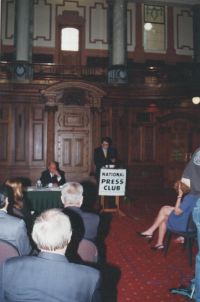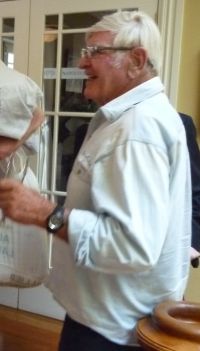
The death at 93 of National Press Club vice president Peter Bush brings to end the career of the nation’s most storied living journalist. He covered test matches from the age of 17 and was a constant feature of international touch lines until quite recent times.
Though most celebrated for his work as a sports photographer, especially as a rugby photographer, he was in fact a fully-fledged photo-journalist and a pioneer of the joint craft in southerly latitudes.
He was also one of the very few such practitioners anywhere to have crashed through the not-so-invisible barrier dividing the craft-cum- trade from the arts.
A curated exhibition of his works known as Hard on The Heels toured Australasian art galleries underlining the breadth of his interests from sport via landscape through to visual social commentary.
He ranked also as a war reporter due to his coverage of the New Zealand participation in the Malaya Emergency.
At home he was a noted chronicler of the outdoors an interest which resulted in the book High Summer on the Heaphy Track and also a book on farming centred on high country hill stations.
He was particularly intrigued by life in remote parts and the people who earned their livings there which he commemorated also in his book South Island Wide.
His interest in travel extended beyond New Zealand and quite later in his career he produced a travel book on the United States.
He became a noted recorder of popular culture with his coverage of early visiting celebrities such as the Beatles, Eartha Kitt, Cliff Richard and David Bowie.
Peter Bush became one of the rare practitioners when he himself became the subject of considerable coverage notably in a television documentary series.
Possessed of a resonant deep voice and with his lived-in visage Peter Bush attracted as much if not more attention than many of the people he was assigned to cover.
First and foremost he considered himself a newsman having honed his skills in the dailies and then on the weeklies notably Truth which heralded the Murdoch era before Murdoch himself set up shop here.
His core speciality Rugby saw his intervention in terms of coverage with the social and political disruptions that shook Australasia from the late 1960s onward, notably the 1981 Springbok tour.
He was remarkable in that he had a curious gift of intimacy which allowed him to relate to others of any walk of life as if he had always known them. His mere presence was enough to enliven any gathering on anything at all.
He had known and conversed with such global figures as Nelson Mandela and Pope John Paul 11 among so many feted local and international movers and shakers.
Rarely, and only when asked, would he dwell on his encounters with the great and the good.
He preferred to fall back on vignettes of his days with the army and the merchant navy and especially on tales from the West Coast of his boyhood.
He straddled the technological dividing line starting when film had to be physically transported to the newspaper dark room to the current era of digital end-to-end throughput.
His decision to go freelance gave him the journalistic depth of field that meshed with his widely diverse interests.
A certain deliberate devil-may-care style of bonhomie successfully disguised a meticulous attention to detail so evident for example in the demanding intricacies of cataloguing his increasingly immense archive.
He was appointed vice president of the National Press Club during the presidency of the late Dominion editor Jack Kelleher and he went on to serve in this role for 40 years.
He was made QSM (1991) and CNZM (2011)
He is survived by his partner, Jane, his two daughters, Trinette and Rachel, stepchildren Carl and Karina, and grandchildren.
















